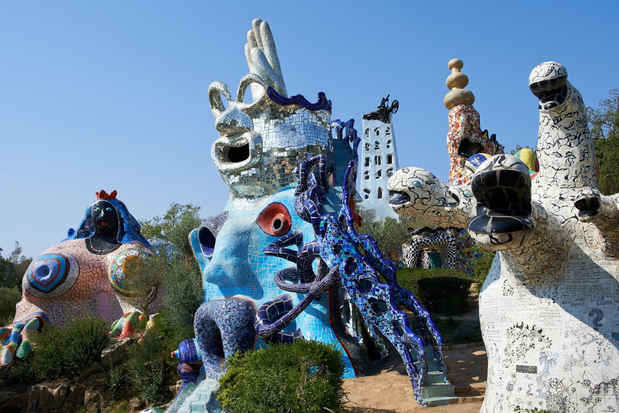Niki de Saint Phalle Exhibition
MOMA PS1

This event has ended.
MoMA PS1 presents the first New York museum exhibition of the work of visionary feminist artist Niki de Saint Phalle (American and French, 1930‒2002). Niki de Saint Phalle: Structures for Life will feature over 200 works created from the mid-1960s until the artist’s death, including sculptures, prints, drawings, jewelry, films, and archival materials. Highlighting Saint Phalle’s interdisciplinary approach and engagement with key social and political issues, the exhibition will focus on works that she created to transform environments, individuals, and society.
From the beginning of her career in the 1950s, Saint Phalle pushed against accepted artistic practices, creating work that used assemblage as well as performative and collaborative modes of production. Saint Phalle initially gained attention in the early 1960s with her Tirs, paintings produced by firing a gun at plaster reliefs to release pockets of paint, and Nanas, brightly colored sculptures of female figures whose sinuous curves would inform much of her work to come. Beginning in the late 1960s, Saint Phalle started producing large-scale sculptures, which led to an expansion of her practice into architectural projects, sculpture gardens, books, prints, films, theater sets, clothing, jewelry, and, famously, her own perfume.
Central to the exhibition is an examination of Saint Phalle’s large-scale outdoor sculptures and architectural projects, including Le rêve de l’oiseau (built for Rainer von Diez between 1968 and 1971); Golem, a playground in Jerusalem (1971-72); Le Dragon de Knokke, a children’s playhouse in Belgium (1973-75); and La fontaine Stravinsky (1983); among others. These are represented in the exhibition by the many models she made in preparation for and in homage to her architectural works, as well as through a wide selection of archival materials—many of which have never before been exhibited.
The ideas explored in these works culminated in Saint Phalle’s central life project, Tarot Garden, a massive architectural park outside Rome, Italy, which she began constructing in the late 1970s and continued to develop alongside key collaborators until her death. Opened to the public in 1998, the garden and its structures, which are based on the 22 Major Arcana of the tarot deck, allow for moments of interaction and reflection that underscore Saint Phalle’s use of art to alter perception. The exhibition will include photographs and drawings of Tarot.
Garden as well as models that Saint Phalle created for its various structures. For Saint Phalle, these structures were charged spaces of imagination from which she envisioned experimental societies emerging, places “where you could have a new kind of life, to just be free.”
Saint Phalle also created a series of innovative works that reflect an ethos of collaboration and engagement with the politics of social space. Addressing subjects that ranged from women’s rights to climate change and HIV/AIDS awareness, Saint Phalle was often at the vanguard in addressing the social and political issues of her time. Her illustrated book, AIDS: You Can’t Catch It Holding Hands (1986), written in collaboration with Dr. Silvio Barandun, worked to destigmatize the disease and was translated into six languages. Niki de Saint Phalle: Structures for Life is organized by Ruba Katrib, Curator, with Josephine Graf, Assistant Curator, MoMA PS1.
Niki de Saint Phalle was born in Neuilly-sur-Seine, France and raised in New York City. In 1948, at age 18, she married the writer Harry Matthews. They moved to Paris in 1952, and shortly thereafter Saint Phalle was hospitalized for a nervous breakdown and began painting as a therapeutic activity. In the late 1950s, Saint Phalle met artist Jean Tinguely, an important collaborator whom she married in 1971. She was the only female member of the Nouveau Réalisme group with Tinguely, Arman, Christo, and Yves Klein, among others. In 1961, the first solo exhibition of Saint Phalle’s work was held at Galerie J, Paris. That same year, her work was included in the exhibition The Art of Assemblage at The Museum of Modern Art, New York. Saint Phalle was the subject of a retrospective at the Ulm Museum, Germany, and Centre Pompidou, Paris in 1980, and at the Kunsthalle Bonn in 1992. In 1994, she moved to California, where she lived until her death in 2002. Posthumously, her work has been the subject of major exhibitions at Tate Liverpool (2008); Grand Palais, Paris (2014); and the Power Station of Art, Shanghai (2018). Saint Phalle is represented in public collections including The Museum of Modern Art, New York; Musée d’Art Moderne de la Ville de Paris, Paris; Stedelijk Museum, Amsterdam; and Tate Gallery, London.
Media
Schedule
from March 11, 2021 to September 06, 2021